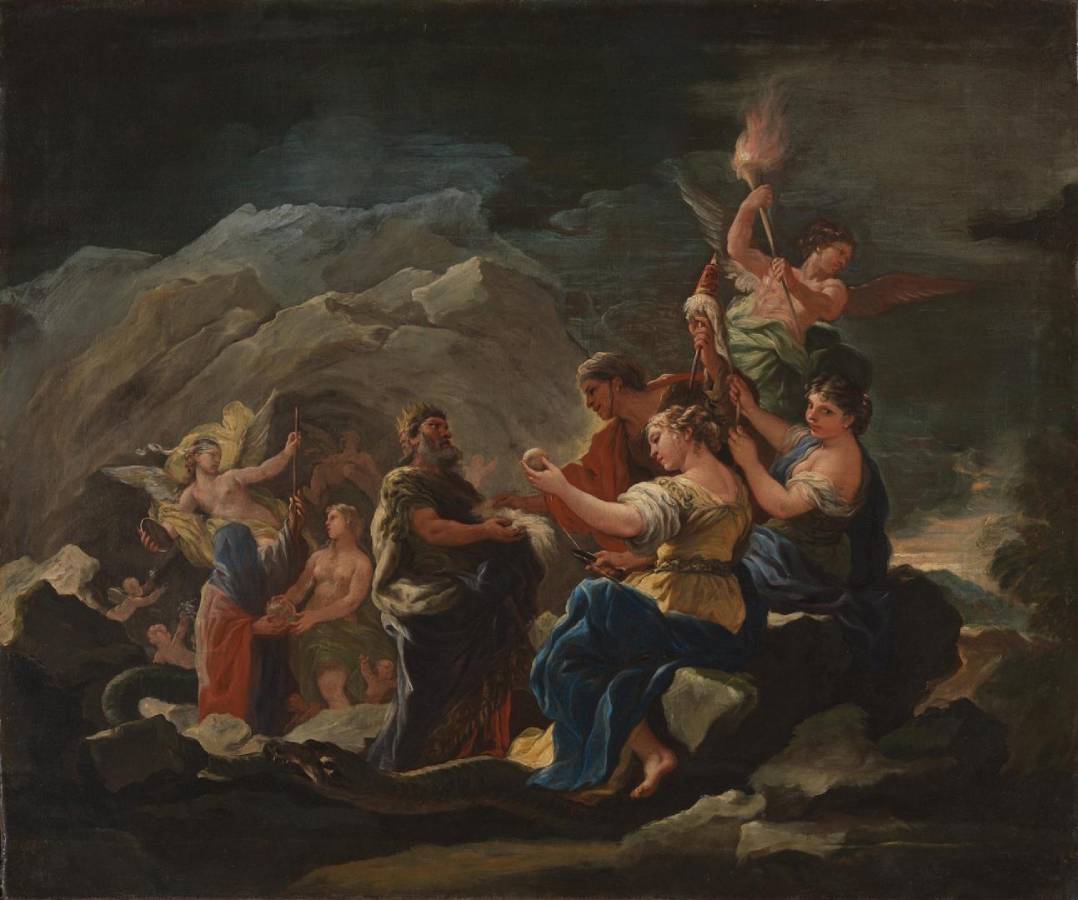Giordano, Luca (1634-1705)
Antro dell’eternità (The Cave of Eternity)
early 1680s
Oil on canvas, 73.1 x 87.5 cm
National Gallery, London
This modello, or detailed oil study, is one of a group of twelve – ten of which are in the National Gallery – that Giordano made in preparation for the ceiling frescoes in the Palazzo Medici Riccardi in Florence in 1682–5. The overall theme of the highly elaborate, showpiece frescoes is the progress of mankind by means of Wisdom and Virtue. This scene corresponds to that painted on one of the two short walls of the grand Galleria, directly opposite the entrance, above which is Minerva as Protectress of the Arts and Sciences.
Here, Giordano presents a gathering of mythological figures associated with time and mortality. They are linked loosely together, encircled with a serpent biting its tail: a symbol of Eternity. The central crowned figure is Janus, the Roman god who looks both to the future and the past (January is named after him). You can just make out that he has two faces – one looking forwards, the other backwards. He is holding out the fleece from which the Three Fates draw out the thread of life. Working together they fulfil their mythological role and form a circle of their own: one plucks at the fleece, a second works it on a spindle while looking out at us knowingly, and a third – Atropos, who has the power to end human life – is about to cut the finished thread. Above them, holding up a flaming torch, is Prometheus. He was the god who, according to Greek myth, created humans and gave them fire, which led to the development of civilisation.
The hooded figure in the rocky, mountainous background is probably Demagorgon, a pagan monster usually associated with hell and the underworld, but also sometimes considered a god of the earth or of creation and connected with fate or fortune. In Cinque Canti, a poem by Ludovico Ariosto, Demagorgon has a mountain palace where every five years the three Fates come to him to report on their activities. Here, however, he is apparently receiving an orb from Nature, who is dressed in green and from whose breasts milk pours, as well as a staff or sceptre from Fortune, who is winged and blindfolded. Sketched in the shadows of the cave entrance behind them is the winged figure of Chronos, who represents Time. (NG)
Modelli for the Palazzo Medici Riccardi:
 Giordano, Luca (1634-1705)
Giordano, Luca (1634-1705)
Allegoria della Fortezza
early 1680s
National Gallery, London
 Giordano, Luca (1634-1705)
Giordano, Luca (1634-1705)
Allegoria della Giustizia
early 1680s
National Gallery, London
 Giordano, Luca (1634-1705)
Giordano, Luca (1634-1705)
Allegoria della Prudenza
early 1680s
National Gallery, London
 Giordano, Luca (1634-1705)
Giordano, Luca (1634-1705)
Allegoria della Sapienza Divina
early 1680s
National Gallery, London
 Giordano, Luca (1634-1705)
Giordano, Luca (1634-1705)
Allegoria della Temperanza
early 1680s
National Gallery, London
 Giordano, Luca (1634-1705)
Giordano, Luca (1634-1705)
Allegoria dell’Agricoltura
early 1680s
National Gallery, London
 Giordano, Luca (1634-1705)
Giordano, Luca (1634-1705)
Apoteosi dei Medici
early 1680s
National Gallery, London
 Giordano, Luca (1634-1705)
Giordano, Luca (1634-1705)
La barca di Caronte e il ratto di Proserpina
early 1680s
National Gallery, London
 Giordano, Luca (1634-1705)
Giordano, Luca (1634-1705)
Minerva protettrice delle Arti e delle Scienze
early 1680s
National Gallery, London
This group of ten paintings was made by Giordano as a series of detailed oil studies (or modelli) for the ceiling frescoes in the Palazzo Medici Riccardi in Florence, which are among the artist’s finest achievements. The modelli are part of a set of 12 (the other two are in private collections).
Nine of the paintings relate to the ceiling of the highly ornate Galleria, built to house a precious collection of antiquities and function as a public reception room. The other is associated with the ceiling of the adjacent Library. The overall theme in the Galleria is the elevation of mankind through Wisdom and Virtue, using allegorical and mythological figures to represent different strengths and traits. It culminates in a centrepiece which presents the wealthy Medici family as the paradigm of both these qualities.
Giordano seems to have worked up these modelli to clarify his designs and may have presented them to his client, the Marquess Francesco Riccardi, for approval before the frescoes were executed. (NG)
